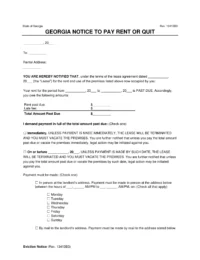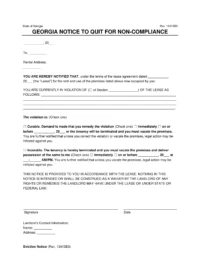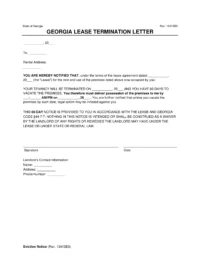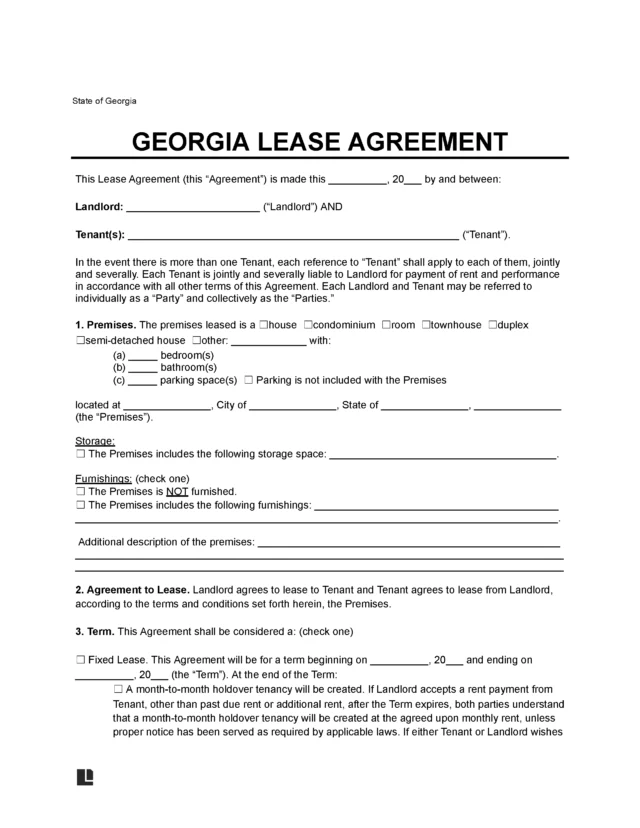Understanding Eviction Notices in Georgia
Landlords in Georgia must give tenants proper notice before starting a formal eviction process. The notice must include the violation (such as unpaid rent or lease breaches) and a deadline to resolve the issue.
Under Georgia law, most evictions now require a 3-day written notice before landlords can file a dispossessory affidavit with the local magistrate court. For other violations, notice may be immediate. Legal Templates’ eviction notice builder helps landlords create state-compliant forms in minutes.
Types of Eviction Notices in Georgia
Georgia landlords must use the correct type of eviction notice based on the reason for ending the tenancy. Each notice has its own legal requirements and timeframes. Choosing the right notice is the first step toward a valid eviction process.
3-Day Notice to Pay Rent or Quit
Landlords in Georgia must give tenants 3 days to pay overdue rent or vacate the property before filing for eviction. This requirement is set by Title 44, Chapter 7, Section 50 of the Official Code of Georgia. The notice must clearly state the amount owed and the deadline to avoid legal action.
3-Day Notice to Pay Rent or Quit
If the tenant doesn’t pay their rent, the landlord can submit this eviction notice demanding possession of the property.
Immediate Notice to Quit for Non-Compliance
For lease violations other than unpaid rent — like damage to the property, illegal activity, or repeated disturbances — Georgia law permits landlords to issue an immediate notice to quit without offering time to cure (GA Code § 44-7-50).
Immediate Notice to Quit for Non-Compliance
Used by a landlord to notify their tenant that they’ve violated the terms of their lease.
60-Day Notice to Terminate Tenancy
To terminate a month-to-month or at-will lease, landlords must give 60 days’ notice, while tenants only need to give 30 days under GA Code § 44-7-7. This applies when there’s no violation, but the landlord wishes to end the rental arrangement.
60-Day Notice Lease Termination
This type of eviction notice is used by a landlord who doesn’t wish to renew a tenant’s lease.
How to Evict a Tenant in Georgia
Evictions in Georgia follow a legal process governed by GA Code § 44-7. The process begins with proper notice and proceeds through the local magistrate court.
Step 1: Serve the Eviction Notice
After receiving the eviction notice, a tenant can pay rent and any additional charges up to 7 days after receiving the eviction lawsuit papers (GA Code § 44-7-52) or move out. If the tenant neither pays nor moves out, the eviction process can be moved through the court system as follows:
Step 2: File the Relevant Documents With the Court
The landlord files a dispossessory affidavit or dispossessory warrant with the court. These documents include the full names of the parties, the reason for eviction, a declaration that the landlord demanded possession of the property but was denied, and the amount of overdue rent.
Step 3: Await the Court’s Judgment
If the court decides in the landlord’s favor, the judge will issue and sign a summons to be served on the tenant. The sheriff personally serves the summons on the renter, leaves it with someone at the tenant’s residence, or posts it on the property. Then, the sheriff mails the tenant a copy by certified mail (tack and mail).
Step 4: Wait for the Tenant to Respond
The renter has 7 days to file a dispossessory answer to the summons in court or on their own. If the tenant answers in a timely manner, the court sets a hearing date within 10 days. If the tenant doesn’t respond, the landlord files a default and asks for a writ of possession.
Step 5: Allow the Sheriff to Serve the Writ
The sheriff serves the writ of possession on the tenant, who has 24 hours to move out. If the tenant refuses to move out, the court schedules a hearing.
If the tenant wins at trial, they may stay. If the landlord wins, the court orders a writ of possession, giving the tenant 10 days to move out. If the tenant still doesn’t move out, the landlord can get the sheriff to forcibly remove the tenant. Both parties can appeal the court’s ruling should they choose.
Related Georgia Court Forms
- Dispossessory Proceeding Affidavit: To begin the eviction process in Georgia, the landlord provides the full names of the parties, the reason for eviction, the declaration that the landlord demanded but was denied possession, and the overdue rent amount.
- Dispossessory Answer: The tenant files this form in answer to the landlord’s summons and lists defenses and counterclaims.
- Dispossessory Notice of Trial Date: A notice of the trial date issued from the court to the parties.
- Application and Order for Default Writ: The court’s order that a default was entered against the tenant, and a writ of possession is issued with a directive to the sheriff to serve it.
- Dispossessory Default Writ Tack and Mail: The court’s order that a default was entered against a tenant and a writ of possession is issued. This permits the landlord to post the writ of possession on the tenant’s property as notice to remove themselves and their property.








